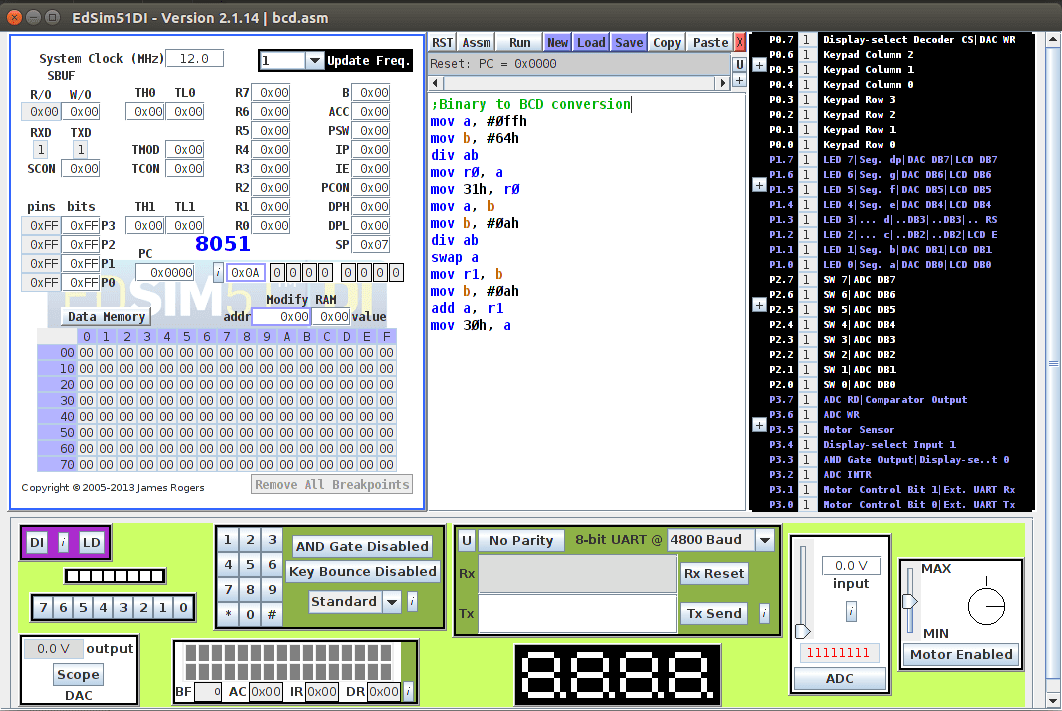

- #8051 SIMULATOR FOR WINDOWS HOW TO#
- #8051 SIMULATOR FOR WINDOWS INSTALL#
- #8051 SIMULATOR FOR WINDOWS ARCHIVE#
- #8051 SIMULATOR FOR WINDOWS CODE#
- #8051 SIMULATOR FOR WINDOWS PC#
The example program " DEMO.A51" is very instructive. Refer to " ASEM_51.DOC" for detail usage.Issue " ASEMW DEMO.A51" within DOS box will process the source file " DEMO.A51" and generate a output file " DEMO.HEX" in Intel-HEX format and a list file " DEMO.LST" in plain text.Download ASEM-51 v1.3 and unzip it into a sub-directory.Heinz, is a free 8051 macro assembler for MS-DOS, Windows and Linux.
#8051 SIMULATOR FOR WINDOWS ARCHIVE#
Unlike the 8085 simulator mentioned above, 8051 simulator is versatile and it comes with numerous peripheral devices like ADC, DAC, 7 Segment & LED displays, Matrix keyboard and Motor.8051 Development Tools 8051 Development ToolsĬ Compiler BASIC Compiler Pascal Compiler DisassemblerĮditor Terminal Emulator Schematic Drawing Datasheet Archive To know more about this simulator, download the developer's documentation of this simulator. Else, it will take time to execute the program in Run all At a Time mode.
#8051 SIMULATOR FOR WINDOWS CODE#
Hence to load data to memory location 8000H, the code #ORG 8000H & #DB 9FH is used. So, the memory address 8000H must contain some data. We all know that LDA instruction fetch the data from memory address to accumulator. The instruction #ORG 7000H is used to store the mnemonics from the address 7000H. Initializes an area byte by byte, in successive memory locations(Define Byte) until all values are stored. The next block of instruction should be stored in memory locations starting at 8000H These ORG, DB codes are used in this assembler for certain purposes. This tab displays the status of I/O ports.Ĭheck the simple following example program. First learn something about the interface of the simulator.
#8051 SIMULATOR FOR WINDOWS HOW TO#
At the bottom of this 8085 simulator topic, I would have written how to execute a program. The above image is the user interface of the simulator. Just follow some simple instructions given below.

Now, you can start to work with your codes. If you have a JRM installed machine, the simulator would have been opened. Then, double click on the file downloaded.
#8051 SIMULATOR FOR WINDOWS INSTALL#
sudo apt-get install default-jre 8085 Simulatorįirst of all download the Java byte code of the simulator from the link - 8085 Simulator.

Other Linux users use Google to find way to install JRE. JRE for Windows usersĭebian, Ubuntu & Linux Mint users, run the following command on terminal to install JRM on your machine. Download and install JRE using the link given. To work with the simulators which I'm going to recommend you in this post, you need to install 'Java Runtime Environment' as the simulators are built using Java. Prerequisites for both 8085 & 8051 Simulators
#8051 SIMULATOR FOR WINDOWS PC#
One can execute assembly language programs on the PC itself. So, development kits are not at all needed for gearing-up for practical exams. Simulators are nothing but computer programs that are capable of doing the same thing as the real devices do. Unfortunately, most of us won't have access to those trainer kits when we want. So, one must know how to write programs and feed it into 8085 & 8051 kits to get proper output. Almost all Engineering students might have Microprocessors & Microcontrollers laboratory classes in the course of 4 year degree.


 0 kommentar(er)
0 kommentar(er)
